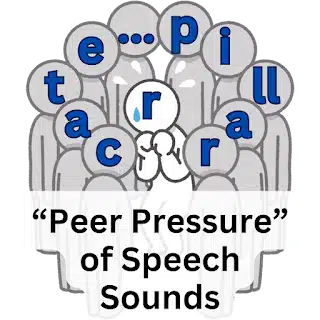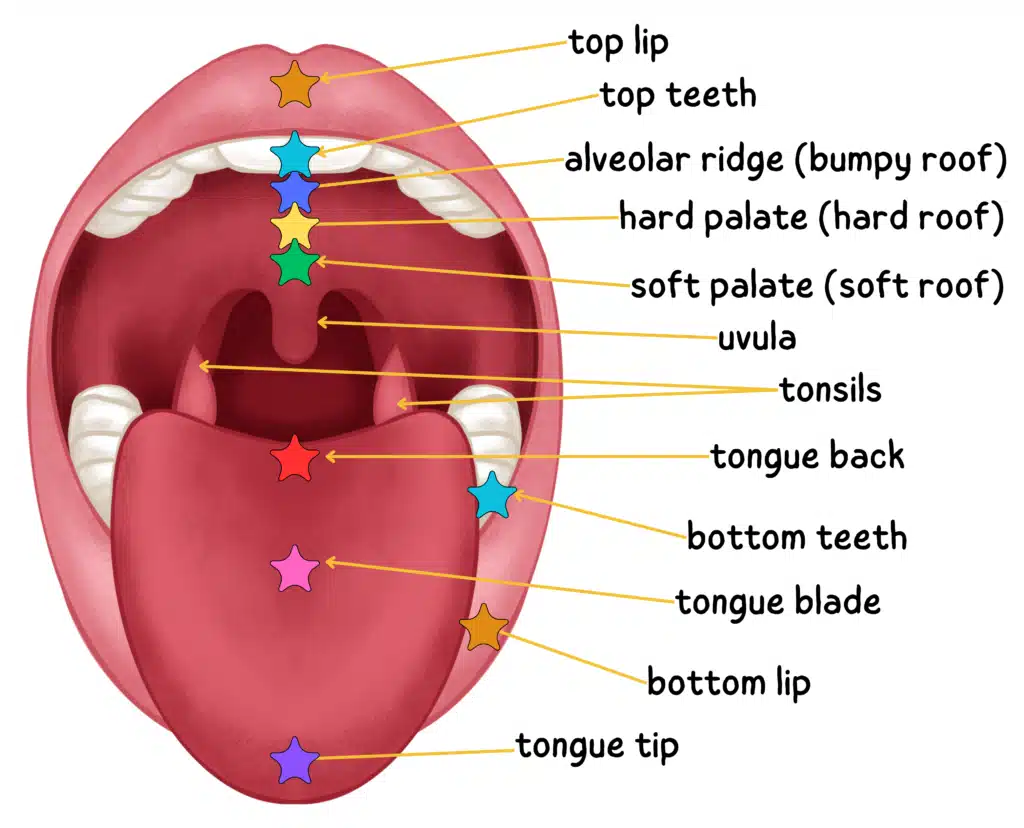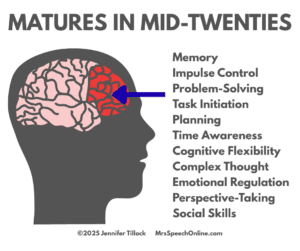
The Peer Pressure of Speech Sounds
Have you ever wondered why we often say “comfortable” instead of “comfterble”? Or why “strength” can sometimes sound like “strenkth”? These seemingly random variations in pronunciation are actually fascinating examples of everyday phonological processes. Every time we talk, sounds influence each other. You might think of these processes as the “peer pressure” nearby sounds exert on each other.
Why do we use processes?
Imagine typing an essay. What if you are only allowed to strike the keys precisely on the center, with good finger & wrist posture. Would it take you longer to type? Would it seem awkward and more fatiguing?

Phonological processes, particularly coarticulation, are not random, or even necessarily erroneous, occurrences. They reflect the efficient and dynamic nature of human speech production.
Our speech system is incredibly complex. Coarticulation allows us to produce speech smoothly and quickly by anticipating and adjusting to upcoming sounds. By anticipating the next sound, we can position our articulators (tongue, lips, jaw) in advance. This makes speech production more efficient and fluid without (usually) impairing the listener’s understanding.
They Happen All the Time
SLPs often focus on phonological processes as patterns of errors in articulation therapy. However, it’s crucial to remember that these processes are also a natural part of everyday speech for all of us.
It’s important to remember that when children are sounding out words, they are often applying these natural and normal “shortcuts” of speech. This means their pronunciations (and spellings) may not always perfectly match the standard pronunciation. Instead, they reflect the natural and dynamic nature of spoken language.
This blog post will explore key phonological processes that we all use everyday, like coarticulation, assimilation, epenthesis, and elision. We’ll discuss how understanding these processes can benefit both teachers and Speech-Language Pathologists (SLPs) in the classroom.
The “Peer Pressure” of Speech Sounds
Assimilation: Similar Sounds Mesh

Assimilation is a specific type of coarticulation where two similarly produced sounds are combined. See the above image where the octagon and circle (similar shapes) combine. They are both visible, the color of the circle impacted by the color of the octagon. We might compare it to friends who spend a lot of time together, who often start to share similar mannerisms.
Example: “Ten plus two” often becomes “tem plus two.” The /n/ becomes more like the following /p/ sound. In “I miss you”, the /s/ responds to the “peer pressure” of the /y/, becoming more like the /sh.
Coproduction: Sounds Overlap

In coproduction, another type of coarticulation, sounds that use different articulators are overlapped. In the illustration above, the two circles overlap, but both circles are still visible. Using our analogy of typing, we anticipate the next key and position our finger accordingly before the current keystroke is fully completed.
Example: Lips begin to round for the /u/ in “suit” while still producing the /s/. Words ending with a vowel + nasal, such as “can”, often have some nasality in the vowel.
Epenthesis: Adding Sounds

Epenthesis involves the insertion of a sound that doesn’t exist in the underlying form of a word. Look at the image above, where two shapes become three. Imagine trying to keep your pants up. You could use a belt or suspenders, or you could even add a small clip to help keep them in place. Epenthesis is similar. It’s like adding a small “clip” (an extra sound) to a word to make it easier to pronounce.
Example: We often pronounce “Athlete” as “ath-uh-lete.” “Tenth” often has a slight /t/ sound between the /n/ and /θ/.
Elision: Deleting Sounds

Elision is the omission of a sound within a word. See how one of the shapes above is omitted. Imagine you have a pair of pants that are slightly too long. To make them fit better, you might hem them, essentially “deleting” a portion of the fabric. Elision is similar – we “delete” or omit sounds from words during speech to make them easier and quicker to pronounce.
Example: Frequently, we omit one of two /r/ sounds in a word, such as “caterpillar” or “governor.” We also typically remove the middle “e” in “camera.” We use “shortcuts” like “gonna” instead of “going to”, or “dunno” for “don’t know”. In fact, contractions are really a form of elision themselves!
Why Do These Everyday Phonological Processes Matter in the Classroom?
Understanding these common speech patterns is crucial for both teachers and SLPs. It provides valuable insights into the complexities of speech, language, and literacy development. Here are some key benefits:
Improved Reading:

- Understanding how sounds change in speech is crucial for developing strong reading skills. Recognizing that sounds can influence each other helps students bridge the gap between spoken and written language.
- Coarticulation plays a key role in fluent reading. When students understand how sounds are produced and how they influence each other, they anticipate how words will sound. This makes reading more fluent and accurate.
- For example, we typically pronounce the /t/ in “butter” as a flap (soft, rapid /d/). Knowing this helps students anticipate and decode the word more easily. It allows students to become more flexible and adaptable readers, able to recognize words in a variety of spoken contexts.
- Furthermore, understanding phonological processes can help students navigate the complexities of dialect in literature. It aids underastanding the regional or cultural “peer pressure” of sounds. This empowers students to better understand and appreciate the diversity of spoken language, and its written representation.
Enhanced Phonics Instruction:
- Phonological processes help explain the “why” behind seemingly inconsistent spelling rules. For example, to help students understand why “camera” is spelled differently than it sounds, we might teach the concept of elision.
- This knowledge empowers teachers to go beyond rote memorization of phonics rules. By understanding the underlying reasons for these rules, teachers can provide more meaningful and insightful phonics instruction.
- Teachers can use this knowledge to address common student misconceptions about spelling. For example, students may consistently misspell words with frequent elisions. Teachers can explicitly address these patterns and help students understand the connection between pronunciation and spelling.
Spelling:
- Understanding phonological processes can help students become more aware of the discrepancies between how words are spoken and how they are written. Students who know that they pronounce the /t/ in “butter” with a flap understand that it’s still spelled with a “t.”
- Phonological processes can explain why some words are spelled differently than they sound. For instance, knowing about elision can help students understand why “camera” can be pronounced “cam-ra” and why the spelling reflects the full pronunciation.
- This knowledge can help teachers identify patterns in students’ spelling errors and provide targeted interventions. If a student consistently omits sounds that are often elided in speech, teachers can provide specific instruction and practice to address this pattern.
Phonemic Awareness:
- Understanding typical phonological processes helps students develop a deeper awareness of the sounds that make up words. By recognizing how sounds can change and interact within words, students become more attuned to the subtle nuances of speech.
- This enhanced awareness of individual sounds is crucial for developing strong phonemic awareness skills. Phonemic awareness, the ability to identify and manipulate individual sounds in words, is a foundational skill for reading and writing development.
Essential for the Understanding of Everyday Processes:

Before students can truly grasp the intricacies of these everyday phonological processes, they must have a solid foundation in the basics of speech sound production. Understanding place, manner, and voice is paramount.
Place refers to where in the mouth the sound is produced (e.g., alveolar ridge, lips). Manner refers to how the sound is produced (e.g., stop, fricative, nasal). Voice refers to whether the vocal cords vibrate during sound production.
This knowledge is essential for recognizing how sounds influence each other and understanding why certain changes occur. For example, to understand why the /n/ in “ten plus two” assimilates to an /m/, students need to know that both /m/ and /p/ sounds are produced with the lips.
See my recent blog post, Developing Phonological Awareness: Phoneme Categorization by Place, Manner, and Voice, for more information on speech sound production!
“Peer Pressure” of Speech Sounds – Activities for the Classroom:
- Minimal Pair Activities: Use minimal pairs (words that differ by only one phoneme) to explore how sound changes affect meaning.
- Sound Sorting: Have students sort words based on how sounds change within them, or where a sound is made.
- Read Aloud: Encourage students to pay attention to how sounds change during reading.
- Discussion: Discuss with students how sounds change when speaking carefully or when in a hurry. Discuss different dialects and accents.
- Identify Examples: Find more examples of the above processes, and have students read them carefully with good enunciation. Then have them say them quickly, as if talking to a friend. Have students identify what sounds changed.
- Tongue Twisters: Use tongue twisters to explore how sounds interact. Have students identify WHY the tongue twister was difficult!
Conclusion
By explicitly teaching students about the “peer pressure” among sounds – how they influence and shape each other – we can help them become more aware of the subtle nuances of speech. This awareness can significantly enhance their understanding and use of speech, language, and literacy, ultimately leading to more confident readers and writers.
Happy Processing!
Social Media Icons: designed by rawpixel.com – Freepik.com













